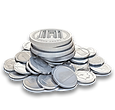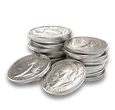How Rarity and Population Reports Affect Auction Results
- GoldsilverJapan

- Oct 4
- 5 min read
In the world of coin collecting and numismatic investment, two major concepts often come up: rarity and population reports. These elements are fundamental to determining a coin's perceived value in the market, particularly at auction, where competitive bidding can skyrocket prices to astonishing levels. But how exactly do rarity and population figures influence auction results? Why do two seemingly similar coins fetch drastically different prices?
This comprehensive guide explores the intricate relationship between rarity, population reports, and auction prices—giving collectors, investors, and enthusiasts a data-driven yet practical understanding of how the market reacts to these key factors.
🔍 What Is Rarity in Numismatics?
In simple terms, rarity refers to how scarce a coin is in the market. But rarity is not only about how many coins were minted—it’s also about how many have survived in collectible condition.
Types of Rarity
Absolute Rarity This refers to the total number of known examples of a coin. For example, if only five coins exist, it is absolutely rare.
Relative Rarity This is context-specific. A coin might be common in circulated grades but rare in Mint State (MS) or Proof grades.
Condition Rarity Some coins are abundant in lower grades but extremely scarce in high grades. For instance, a Peace Dollar in MS-67 condition is much rarer than one in MS-60.
📊 What Are Population Reports?
Population reports are published statistics by third-party grading services such as PCGS (Professional Coin Grading Service) and NGC (Numismatic Guaranty Corporation). These reports indicate how many coins have been graded at each level of preservation.
For example:
Coin | Grade | PCGS Population | NGC Population |
1881-S Morgan Dollar | MS-65 | 22,000 | 19,000 |
1881-S Morgan Dollar | MS-68 | 30 | 18 |
These reports provide transparency to the market and are essential tools for investors, collectors, and dealers alike.
🎯 Why Do These Metrics Matter at Auction?
At auctions, particularly those held by major houses like Heritage Auctions, Stack’s Bowers, or Great Collections, competition is fierce. When bidders perceive a coin to be rare and highly graded, they are more likely to bid aggressively.
Here’s how rarity and population influence auction outcomes:
1. Increased Demand Due to Perceived Scarcity
When population reports show that only a few examples of a coin exist in a certain grade, collectors are incentivized to bid high, fearing that they may not see the coin again in that condition.
2. Registry Set Pressure
Both PCGS and NGC allow collectors to build registry sets, which are competitive showcases of high-grade coins. To top these registries, collectors must acquire the finest known examples—often driving auction prices into record-breaking territory.
3. Marketing & Presentation
Auction houses often highlight population data in catalogs and previews. Terms like Top Pop, Finest Known, and Only One Graded Higher act as psychological triggers that justify higher bids.
🏆 Real Auction Examples: Rarity and Population Impact
Let’s look at actual cases where rarity and population data dramatically influenced the hammer price.
🪙 1. 1907 Ultra High Relief Saint-Gaudens Double Eagle
Population: Fewer than 25 known
Auction Price: $2.7 million (Heritage Auctions, 2012)
Reason: The rarity in combination with the artistic merit and historical significance made this coin a holy grail among collectors.
🪙 2. 1913 Liberty Head Nickel
Population: 5 known
Auction Price: Over $4 million
Reason: The scarcity is undisputed, and competition among collectors has never waned.
🪙 3. 1996-W Roosevelt Dime in MS70
Population: Extremely low in MS70
Auction Price: $4,000+
Reason: While common in circulation, MS70 examples are elusive, particularly with the "W" mintmark.
🧠 Psychological Factors: Perception Is Power
Even if the total mintage of a coin is high, population reports can manipulate perceived rarity, which is often just as powerful as actual rarity.
A coin with only 10 MS70 examples out of 50,000 graded is perceived as elite.
Collectors pay premiums for “finest known” even if there’s minimal visible difference between grades.
⚠️ Beware of Hidden Factors
While population reports are valuable, they aren't flawless.
1. Grade Inflation
As grading standards evolve, what was once an MS65 may now be considered MS66 or MS64. This affects population data across time.
2. Re-Submissions
Collectors may re-submit coins to grading services hoping for a higher grade. This can inflate the population count if cracked-out coins are not removed from records.
3. Uncertified Coins
Population reports only cover graded coins. There may be ungraded or raw coins in private collections that alter the real supply.
🔄 Rarity vs Condition: Which Matters More?
In most auction scenarios, a balance between rarity and condition creates the perfect storm for high prices.
Let’s compare:
Situation | Impact on Price |
Common coin in MS70 | Moderate Premium |
Rare coin in VF | High Premium |
Rare coin in MS65+ | Record-Breaking Premium |
Thus, the "rare AND high-grade" coins are the ones that consistently command eye-popping auction results.
🌐 Global Perspectives: Rarity Across Borders
Different countries and cultures value rarity and population data differently.
🇺🇸 United States
Registry set building is highly competitive.
Graded population is frequently cited in auction listings.
🇯🇵 Japan
Collectors emphasize mint condition but also cultural significance.
Grading is becoming more popular, but many coins remain raw.
🇩🇪 Germany
Historical relevance often trumps population data.
Coins from the Holy Roman Empire and Weimar Republic are favored despite less focus on grading.
🔥 Trends to Watch for 2026
As we approach 2026, several trends are shaping how rarity and population influence auctions:
1. Bullion Premium Contraction
As spot prices of gold (around $3,800) and silver ($47) increase, premiums on rare coins may look more attractive. Investors are moving from bullion to premium numismatics.
2. Digital Transparency
Grading services are launching APIs and apps that allow real-time access to population reports. This allows more accurate bidding behavior.
3. Auction Platform Expansion
More platforms (e.g., eBay Live, Heritage Live, and Great Collections) are integrating population filters—so buyers are informed in real-time during bidding.
🧮 How to Use Population Reports Strategically
Here’s how smart collectors leverage rarity and population reports to their advantage:
1. Timing the Market
Buy when the coin’s population is still low.
Monitor resubmissions that may dilute rarity.
2. Cross-Referencing
Use both PCGS and NGC reports to avoid skewed data.
Third-party platforms like CoinFacts and PCGS Price Guide offer analytics.
3. Investing in “Sleepers”
Look for coins where the current population is low, but collector interest is growing.
📈 Case Study: The Power of Low Population
Coin: 1893-S Morgan Dollar
Mintage: 100,000
PCGS MS65 Population: Less than 5
Recent Auction Result: Over $600,000
Despite being relatively well-known, the small number of top-grade examples turns this coin into an auction powerhouse.
🤔 Rarity vs Demand: Which Wins?
Sometimes a coin is rare—but no one wants it.
Sometimes a coin is common—but everyone wants it.
Auction results depend on the combination of:
Rarity
Condition
Collector Demand
Story or Historical Relevance
Market Timing
You need all five for explosive prices.
🧭 Conclusion: The Road Ahead
Understanding rarity and population reports is essential if you're serious about collecting or investing in rare coins. These aren't just dry numbers—they are narratives, indicators of demand, and often predictors of auction outcomes.
Final Takeaways:
Rarity without demand = slow sale
High population in MS70 = modest premium
Low population in high grade + demand = auction fireworks
Use population reports as a tool, not the only decision-making factor
Monitor how registry sets influence population pressure
As coin markets become more transparent and data-driven, knowing how to interpret and act on population and rarity data can give you a major edge in auctions.











Comments